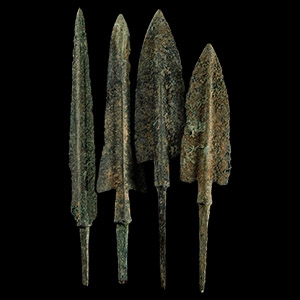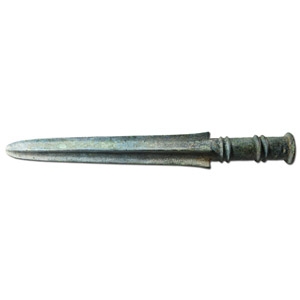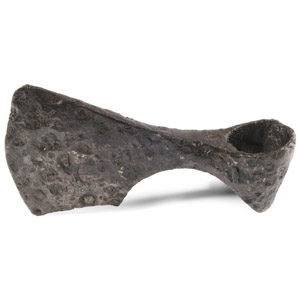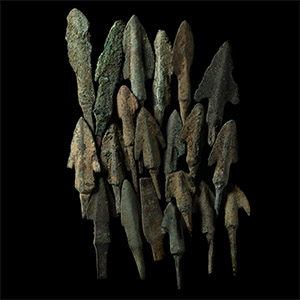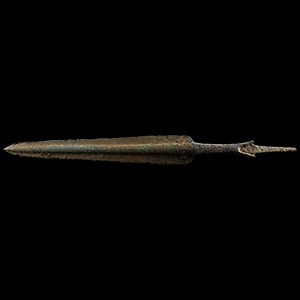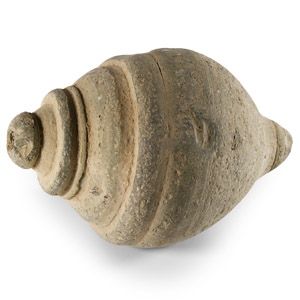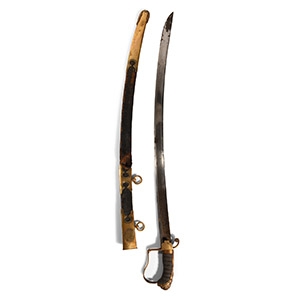Home > Auctions > 5 - 9 December 2023
Ancient Art, Antiquities, Natural History & Coins
Auction Highlights:
Property of a Luton, UK gentleman, by inheritance.
See Capwell, T., Knives, Daggers and Bayonets, Lorenz, 2009, p.190, for general type and details.
The Type 62 is a re-badged British Pattern 1907 bayonet. Siam purchased 10,000 SMLE rifles and Pattern 1907 bayonets from Britain in 1919 to equip the 'Wild Tiger Corps', royal bodyguard of Vajiravudh, King Rama VI (reigned 1910–1925). The tiger figural on the ricasso is representative of the Wild Tiger Corps. Year 2462 on the Buddhist Calendar corresponds to 1919. SMLE rifles and Pattern 1907 bayonets were taken from British stocks, refurbished by Birmingham Small Arms (BSA), and remarked with Siamese markings. The bayonets were shipped with standard steel-mounted leather scabbards. However, the leather rapidly deteriorated in the tropical climate, so the Siamese made a replacement steel scabbard body to which the original steel mounts were brazed.
Found in a churchyard in Derbyshire, UK, before 1950.
Acquired from the son of the clergyman that found it, in 2004.
Property of a Nottinghamshire gentleman.
Acquired 1980-2015.
Ex Abelita family collection.
Accompanied by an academic paper by military specialist Dr Raffaele D'Amato, dated 15 July 2019 and titled 'Eastern Roman Empire - Greek Fire Bomb or Hand Grenade (μεσαίον kακάβιον) 9th-11th century AD'.
Cf. Arendt, W. I., Granaten des 13-14. Jahrhunderts, die an der Wolga gefunden sind, Zeitschrift fur Historische Waffen-und Kostumkunde, 11 (1926-8), p.42; cf. Arendt, W., Die Spharisch-konischen Gefasse aus Gebranntem Ton, ibid; cf. Ayalon, D., Gunpowder and Firearms in the Mamluk Kingdom, London, 1956, p.16; for the way of employment see D'Amato, R., Byzantine Naval Forces 1261-1461, The Roman Empire's Last Marines, Oxford, 2016, plate B, p.41.
Apart from the use of siphons or manual flame-throwers called cheirosiphona, special Roman soldiers employed terracotta grenades, in the form of small jars, abundantly evidenced in archaeological excavations. Such were the γανωτα, vessels (sometimes also in bronze) used for Greek fire. They were called μεσαία kακαβιά or κυτροκακάβια where the former had a bulbous shape and the latter a more cylindrical form.
Acquired 1980-2015.
Ex Abelita family collection.
See for similar arrowheads Muscarella, O.W., Bronze and Iron Ancient Near Eastern Artifacts in the Metropolitan Museum of Art, New York,1988, pp.289ff.
Although different in shape, these four heads are apparently related types of a polythetic group. There are represented two basic deltoid forms: one has a sharp, flat blade, the ends of which extend to form wings or barbs, and a prominent midrib extending into a long tang that often has a stop; the blade shape varies from deltoid to more manifestly triangular. The other form has no barbs, but it has a prominent midrib extending to the tang, it is narrow and leaf shaped.
Acquired in the 1980s-1990s.
Ex an important central London gallery, London W1.
Cf. Ohkonko, N.A., 'A Mongolian Burial Group near Novopavlovka settlement in Stavropol Krai' in Batyr, Traditional Military Culture of the Peoples of Eurasia, no.1, 2010, pp.88-96, fig.7, no.3.
Similar plaques have been found in the burial graves of Mongol commanders and their wives, probably once part of a waist belt from which the sabre and other weapons were hanging. They were found together with arms, unique elements of the costume of fabric and leather, and splendid jewellery of gold and silver.
Ex old English collection.
London art market, pre 2000.
Property of a London, UK, gentleman.
Cf. Gorelik, M., Weapons of Ancient East, IV millennium BC-IV century BC, Saint Petersburg (2003), pl.XXXVIII, nos.54, 58-59, for similar.
The Chinese, having adopted the use of chariot from the west, judging by the monuments and literature used it primarily for archery combat, as evidenced by the absence of spearheads in chariot burials of the Yin Kingdom. But already from the early Zhou Dynasty chariot warriors used a spear. Massive Yin spears were the weapon of dense infantry formations. The shape of our specimen, probably used as standard finial, recalls that of a spear from Zhongzhoulu, Luoyang, Prov. Henan, dated at the 5th-4th centuries B.C., and of two spears from the Zheng fortress of Xinzheng Country, dated to the 4th-3rd century B.C.
From the private collection of a London gentleman, from his grandfather's collection formed before the early 1970s.
See for similar axes Nicolle, D., 'Raiders of the Ice War' in Military Illustrated, March 1996, no.94, pp.26-29, fig.p.28; Sedov, B.B., 'Finno-Ugri i Balti v Epokhi Srednevekovija,' Moscow, 1987, pl.CX, item 44.
During the mid 13th century, the axes were favourite weapons among Baltic people. For instance the Curonian army included lightly armed soldiers who fought with spears, shields, fighting knives and axes. A heavily armed soldier could also carry a sword, a helmet, a shield and a wide-bladed axe.
Acquired 1980-2015.
Ex Abelita family collection.
See Khorasani, M.M., Arms and Armour from Iran. The Bronze Age to the End of the Qajar Period, Tübingen, 2006, figures 463, 467, and 471, for the types.
The most of these arrowheads, having a lozenge-section midrib with thin blades filed sharp at the edges, are typical of the early Iron Age in Luristan. These arrowheads seem to belong to the type V, subcategory types A, C and D according to the classification of Khorasani and Negahban. In the four categories of triangular bronze arrowheads from Luristan, Marlik, and Northern Iran individuated by Negahban, subtypes C and D of type V are larger arrow or javelin heads, C with barbed shoulders and D with round shoulders. Subtype A is substantially similar to C, but smaller. Similar arrowheads are also visible in the Western Iberian and Balkan cultures in the Early Iron Age.
Acquired 1980-2015.
Ex Abelita family collection.
Cf. Khorasani, M.M., Arms and Armour from Iran. The Bronze Age to the End of the Qajar Period, Tübingen, 2006, s.cat 280, for type; Christies, Axel Guttmann Collection of Ancient Arms and Armour, Part 2, London, South Kensington, 28th April 2004, lot 40.
The weapon belongs to the type 1 of the Khorasani spearhead classification, mainly from the Marlik or Amlash areas. Similar pieces have been dated by Stutzinger to 1200-1100 B.C., but the period of use is attested to at least until 1000 B.C.
From the private collection of a London gentleman, from his grandfather's collection formed before the early 1970s.
Cf. Žákovský, P., ‘Caltrop. Contribution to the knowledge of one neglected weapon (in Bohemian language)’ in Studia Minora Facultatis Philosophicae Universitatis Brunensis, M 12-13, 2007-2008, pp.115-132, fig.9, no.4 (type 3 of Žákovský classification).
Caltrops were scattered on battlefields in an effort to stop or slow advancing enemy cavalry or foot soldiers; regardless of how a caltrop lands, one spike is always facing upwards.
Acquired 1980-2015.
Ex Abelita family collection.
Accompanied by an academic paper by military specialist Dr Raffaele D'Amato, dated 15 July 2019 and titled 'Eastern Roman Empire - Greek Fire Bomb or Hand Grenade (μεσαίον kακάβιον) 9th-11th century AD'.
Cf. Arendt, W. I., Granaten des 13-14. Jahrhunderts, die an der Wolga gefunden sind, Zeitschrift fur Historische Waffen-und Kostumkunde, 11 (1926-8), p.42; cf. Arendt, W., Die Spharisch-konischen Gefasse aus Gebranntem Ton, ibid; cf. Ayalon, D., Gunpowder and Firearms in the Mamluk Kingdom, London, 1956, p.16. For this specific shape see Nicolle, D., Arms and Armour of the Crusading Era, 1050-1350 AD,volume II, London, 1999, fig.800b.
This piece was a sort of ceramic fire grenade, similar to the ones used by the Eastern Romans but of Turco-Mongol type. Apart from the use of manual flame-throwers, special corps of soldiers employed terracotta grenades, in the form of small jars, abundantly evidenced in archaeological excavations.
From a Suffolk, UK, private collection.
Richard Johnston took over the sword- and belt-making business from John Bland, who died in 1791, and his surviving partner, Robert Foster, who died in 1798. After Bland's death, Foster and Johnston moved their premises from 70 St. James's Street to number 68 in the same street, and continued the business until Foster's death in 1798, after which Johnston took on another shop, then displaying the address as '38 & 68 St. James's Street'. The cartouche gives the address as '68 St. James's Street', which shows that the sword was produced, finished and sold in 1798.
829 - 840 of 2409 LOTS

.jpg)


.jpg)

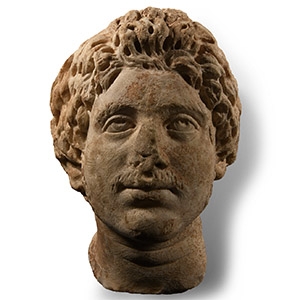
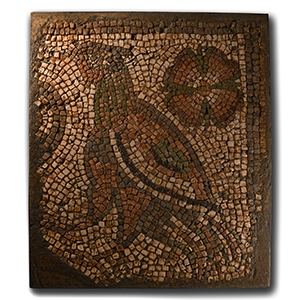
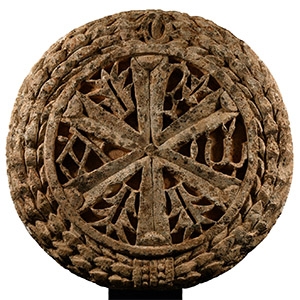


.jpg)


.jpg)
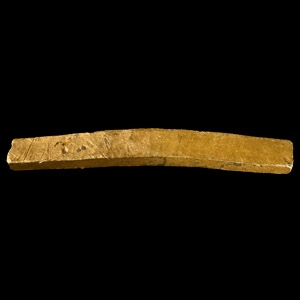
.jpg)
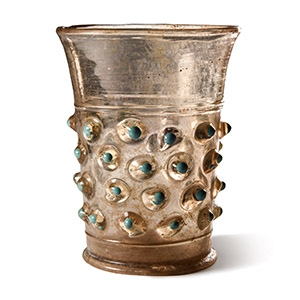

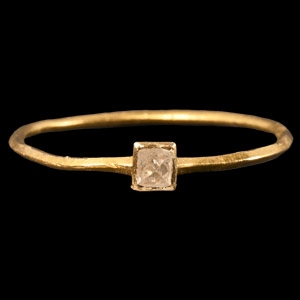

.jpg)


